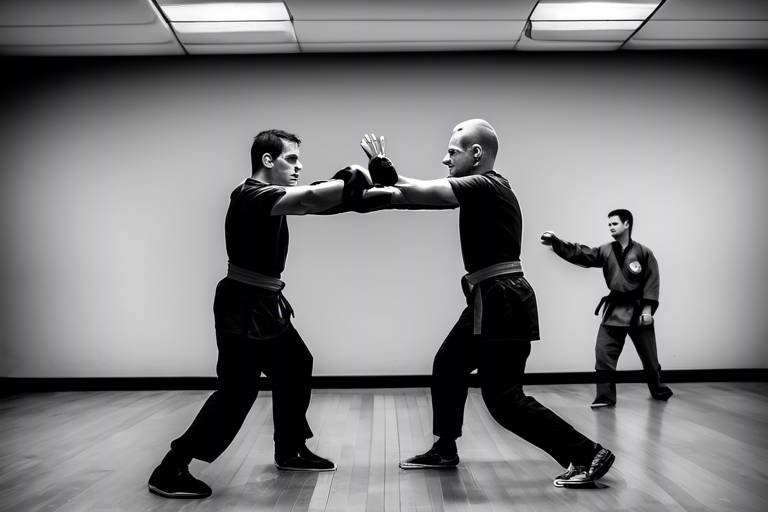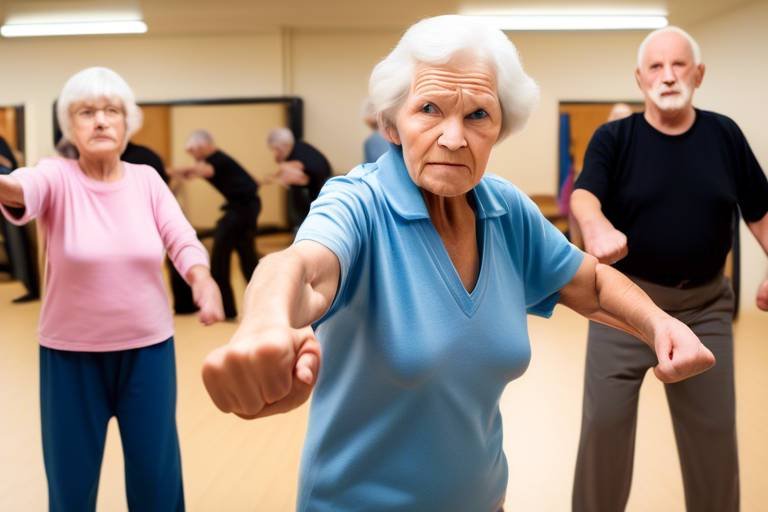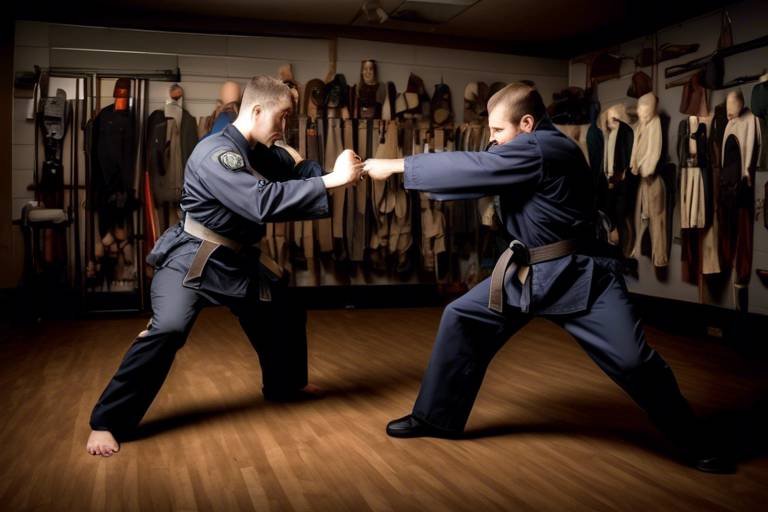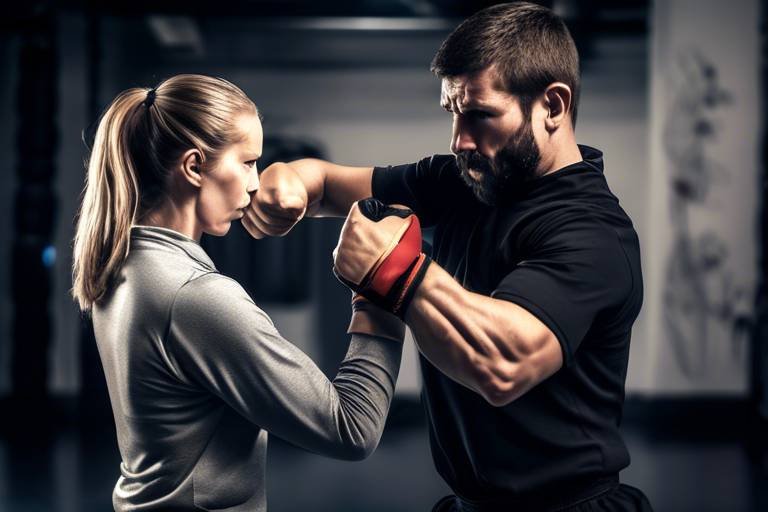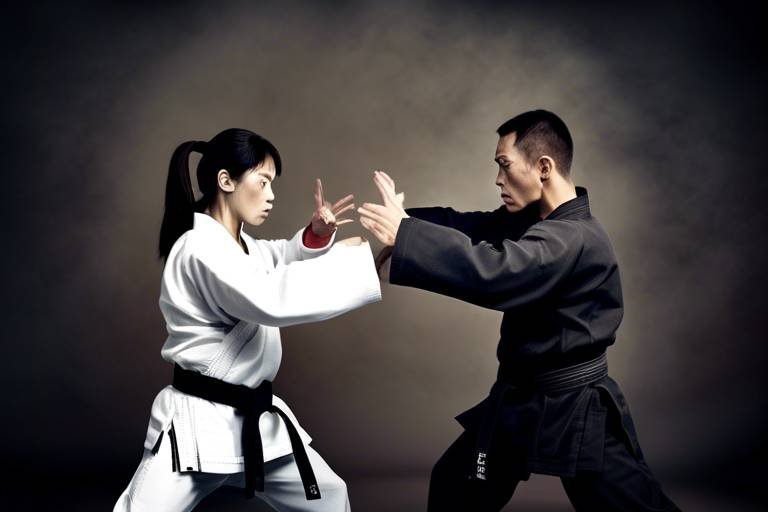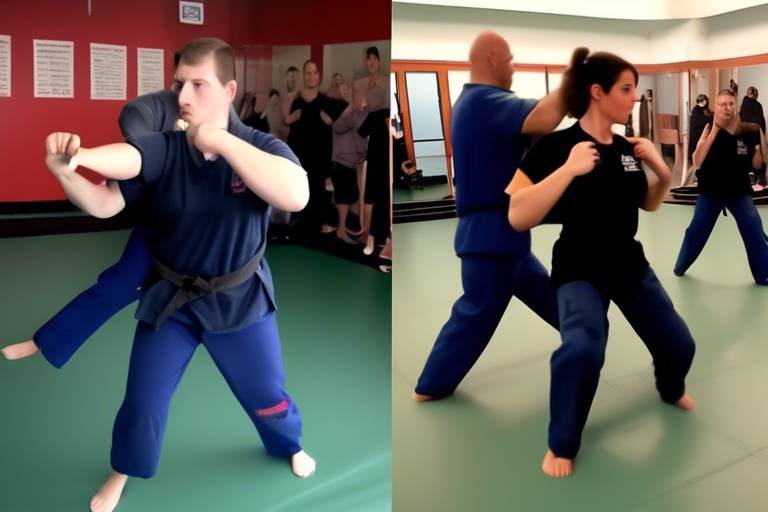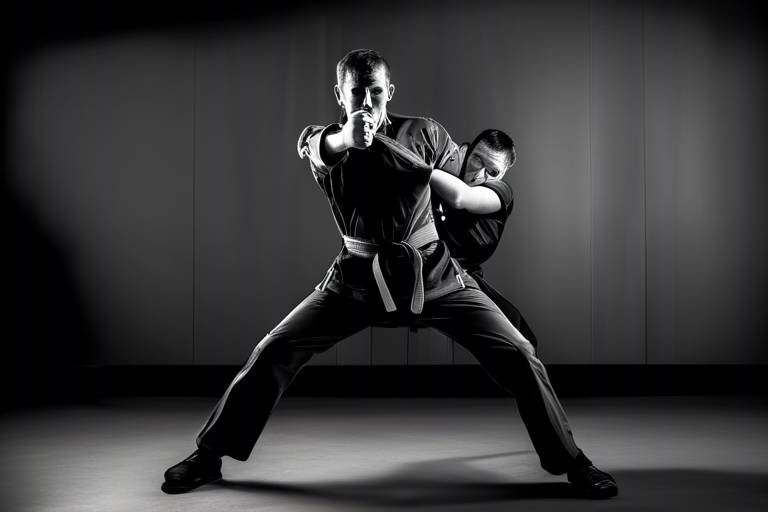How to Use Capsaicin-Based Products as a Self-Defense Technique?
When it comes to personal safety, being prepared is key. One of the most effective ways to enhance your self-defense arsenal is through the use of capsaicin-based products, such as pepper spray. These products are not just tools; they are potent means of protection that can give you the upper hand in threatening situations. Imagine walking down a dimly lit street and suddenly feeling uneasy—having a reliable self-defense product at your disposal can make all the difference. In this article, we will explore how to effectively use these products, their benefits, and the legal considerations you need to keep in mind.
To appreciate the power of capsaicin-based products, it’s essential to understand what capsaicin is. This active component found in chili peppers is responsible for their fiery heat. But it’s not just about the spice; capsaicin has unique properties that make it a formidable ingredient in self-defense tools. When sprayed in the face of an assailant, capsaicin causes intense irritation, leading to temporary blindness and difficulty breathing. This reaction gives you precious moments to escape a dangerous situation. It’s like having a fiery shield in your pocket—one that can deter threats and protect your personal space.
There’s a variety of capsaicin-based products available on the market, each designed for specific self-defense needs. Among the most popular are pepper sprays and gels. These products not only vary in form but also in their effectiveness and ease of use. Understanding the differences can help you choose the right one for your personal safety. For example, pepper sprays typically have a wider range, making them suitable for outdoor use, while gels can be more accurate in close quarters. It’s like choosing between a long-range sniper rifle and a close-combat weapon; each has its unique advantages depending on the scenario.
Pepper spray is arguably the most recognized self-defense tool. Its effectiveness lies in its ability to incapacitate an attacker quickly. With a range of about 10 to 15 feet, it allows you to maintain a safe distance from a potential threat. When selecting a pepper spray, consider factors such as size, spray pattern, and whether it includes a safety lock. A compact canister that fits in your purse or pocket can be a lifesaver. Remember, having the right tool is only half the battle; knowing how to use it effectively is just as crucial.
When choosing between gel and spray formulations, it's vital to understand their pros and cons. Gels tend to stick to the target, reducing the chance of wind blowing the spray back at you. However, they may require closer proximity to the attacker. On the other hand, sprays can disperse over a wider area, but they can also be affected by environmental factors such as wind. Think of it as choosing between a sticky trap and a net; each has its place depending on the situation.
The concentration of capsaicin varies among products, typically measured in SHU (Scoville Heat Units). Higher concentrations mean greater potency, but they also require more responsibility. For self-defense, a concentration of 1.3% to 2% is generally effective, but always consider your comfort level and experience. Selecting the right strength is like choosing the right spice for your dish; too much can be overwhelming, while just the right amount can enhance your experience.
Knowing how to use capsaicin products effectively is crucial for self-defense. Here are some techniques to consider:
- Stay Calm: In a threatening situation, keeping your composure can help you react more effectively.
- Aim for the Eyes: When deploying pepper spray, aim for the attacker's eyes to maximize its effectiveness.
- Know Your Escape Routes: Always have a plan for where to go after using your self-defense tool.
Practicing these techniques can make a world of difference when it comes to your safety.
Before you carry any capsaicin-based product, it’s essential to understand the legal implications involved. Laws regarding pepper spray and similar products vary significantly by location. In some areas, they are legal to carry, while in others, there may be restrictions or permits required. Always check local regulations to avoid any legal repercussions. It’s crucial to stay informed; after all, carrying a self-defense tool should empower you, not put you at risk.
In the United States, most states allow the use of pepper spray, but there are exceptions. For instance, some states have restrictions on the size of the canister or require specific labeling. Here’s a quick overview:
| State | Legal Status |
|---|---|
| California | Legal with restrictions |
| New York | Legal with restrictions |
| New Jersey | Legal with a permit |
| Illinois | Legal |
Improper use of capsaicin products can lead to serious legal issues. For instance, using pepper spray in a non-threatening situation could result in criminal charges. It’s essential to use these tools responsibly and only in self-defense scenarios. Remember, the goal is to protect yourself, not to escalate a situation unnecessarily.
To effectively use capsaicin products, training is essential. Just like learning to ride a bike, practice makes perfect. Taking self-defense classes can significantly enhance your confidence and skills. Many classes incorporate training on how to properly use pepper spray, ensuring you know what to do when the moment arises. Additionally, practicing in simulated scenarios can prepare you for real-life situations, making you feel more equipped to handle threats.
Enrolling in self-defense classes is a fantastic way to gain knowledge and skills. These classes often cover various techniques, including how to use capsaicin products effectively. They can also help you understand the psychology of self-defense, enabling you to react appropriately under pressure.
Practicing in simulated scenarios prepares users for real-life situations. Drills and role-playing can help build muscle memory and response strategies, making you more confident in your ability to defend yourself. It’s like rehearsing for a play; the more you practice, the better you perform when the curtain rises.
In conclusion, capsaicin-based products can be effective self-defense tools when used correctly. Understanding their properties, types, and legal considerations is crucial for anyone looking to enhance their personal safety. Remember, it’s not just about having a self-defense tool; it’s about knowing how to use it effectively and responsibly. Prioritize safety and preparedness in your personal defense strategies, and you’ll feel empowered to face any situation.
Q: Is pepper spray legal everywhere?
A: No, laws vary by location. Always check local regulations before carrying pepper spray.
Q: How long does the effect of pepper spray last?
A: The effects can last anywhere from 15 to 45 minutes, depending on the concentration and exposure.
Q: Can I use pepper spray for self-defense against animals?
A: Yes, many people use pepper spray to deter aggressive animals, but check local laws regarding its use in such situations.

Understanding Capsaicin
Capsaicin is the remarkable compound found in chili peppers that gives them their signature heat. If you've ever bitten into a spicy pepper and felt that fiery burn, you've experienced the effects of capsaicin firsthand. This compound is not just responsible for the heat; it also has intriguing properties that make it a powerful ingredient in self-defense products. When capsaicin comes into contact with the mucous membranes of the eyes, nose, or skin, it triggers a strong burning sensation, which can incapacitate an attacker momentarily. This sensation is due to capsaicin's ability to bind to pain receptors in the body, specifically the TRPV1 receptor, which is responsible for detecting heat and physical abrasion.
But why is this important for self-defense? Imagine being in a threatening situation where you need to protect yourself. A quick spray of a capsaicin-based product can create a window of opportunity for you to escape. The intensity of the burning sensation can cause temporary blindness, difficulty breathing, and disorientation, giving you the crucial seconds needed to get away. It's like having a safety net that can help you break free from danger.
Moreover, capsaicin has been studied for its potential health benefits, including its ability to reduce pain and inflammation. Some people even use capsaicin in topical creams for these very reasons. However, in the context of self-defense, its primary role is to create a diversion and allow you to prioritize your safety. Understanding how capsaicin works is essential, not just for its defensive properties but also for recognizing its potential impact on your assailant.
To further illustrate its effectiveness, consider the following table that summarizes the key effects of capsaicin on the human body:
| Effect | Description |
|---|---|
| Burning Sensation | Intense pain upon contact with mucous membranes. |
| Temporary Blindness | Causes tearing and inability to see clearly. |
| Disorientation | Can lead to confusion and loss of balance. |
| Respiratory Distress | May induce coughing and difficulty breathing. |
In summary, understanding capsaicin is not just about knowing what it is; it's about recognizing its potential as a protective tool. With the right knowledge and preparation, you can effectively use capsaicin-based products to enhance your personal safety. Remember, the more you know about how capsaicin works, the better equipped you'll be to defend yourself in a crisis.

Types of Capsaicin-Based Products
Capsaicin-based products have gained immense popularity in the realm of self-defense, thanks to their effectiveness and ease of use. These products harness the heat of chili peppers, making them a formidable tool against potential threats. Understanding the different types of capsaicin-based products available can empower individuals to make informed choices when it comes to personal safety. Let's dive into the most common options, which include pepper sprays, gels, and other innovative formulations.
One of the most recognized forms of capsaicin-based products is pepper spray. This self-defense tool is often compact and easy to carry, making it a favorite among individuals seeking a reliable means of protection. The effectiveness of pepper spray lies in its ability to incapacitate an attacker temporarily by causing intense irritation to the eyes, skin, and respiratory system. When sprayed directly into an assailant’s face, the effects can be debilitating, providing the victim with a crucial opportunity to escape.
Pepper spray typically comes in various sizes and formulations, allowing users to select a product that best fits their needs. For instance, some sprays are designed for personal use, while others are tailored for law enforcement or security personnel. When choosing a pepper spray, it’s essential to consider factors such as range, spray pattern, and ease of use. The average range of most pepper sprays is about 8 to 12 feet, which provides a safe distance between the user and the attacker.
When it comes to capsaicin-based products, understanding the difference between gel and spray formulations is crucial. Gel formulations tend to stick to the target better than sprays, which can be beneficial in windy conditions where the spray might blow back towards the user. However, gels may require a bit more precision in application. On the other hand, spray formulations offer a wider dispersal pattern, making them easier to use in high-stress situations. Ultimately, the choice between gel and spray should depend on the user’s comfort level and the specific circumstances they anticipate encountering.
Another important aspect to consider is the concentration level of capsaicin in these products. Capsaicin concentration can vary significantly, typically ranging from 0.5% to 3% for consumer-grade pepper sprays. Higher concentrations can lead to more potent effects, but they may also pose a greater risk of causing unintended harm. It’s essential for users to select a product with a concentration level they feel comfortable with, balancing effectiveness with safety. Here’s a quick overview of concentration levels:
| Concentration Level | Effectiveness | Recommended Use |
|---|---|---|
| 0.5% - 1% | Moderate irritation | Personal defense |
| 1% - 2% | High irritation | General self-defense |
| 2% - 3% | Extreme irritation | Law enforcement/security |
With a variety of capsaicin-based products available, individuals can choose the option that best suits their self-defense needs. Whether opting for a compact pepper spray, a gel formulation, or exploring other innovative products, understanding the unique features and applications of each can significantly enhance personal safety.

Pepper Spray
Pepper spray is often hailed as one of the most effective self-defense tools available today. Its popularity stems from its ease of use, portability, and the immediate impact it can have in a threatening situation. When you think about self-defense, pepper spray is like that trusty umbrella you keep in your car; you hope you never have to use it, but when the storm hits, you’re glad it’s there. The main ingredient, capsaicin, is derived from chili peppers, which, when sprayed into an assailant's face, can cause intense irritation to the eyes, skin, and respiratory system, allowing you precious moments to escape.
One of the key advantages of pepper spray is its range. Most pepper sprays can effectively reach targets from 8 to 15 feet away, giving you a safe distance between yourself and a potential attacker. This is crucial because getting too close can put you at risk. Imagine being able to stop a threat from a distance, much like a goalie in soccer stopping a shot from afar. However, it’s essential to choose the right pepper spray for your needs. Factors to consider include the spray pattern, size, and the strength of the capsaicin concentration.
| Feature | Description |
|---|---|
| Range | Typically 8 to 15 feet |
| Size | Compact and easily portable |
| Spray Pattern | Stream, cone, or fog |
| Concentration | Measured in Scoville Heat Units (SHU) |
When selecting a pepper spray, consider the spray pattern. There are three main types: stream, cone, and fog. A stream pattern allows for precise targeting, while a cone pattern disperses a wider area, making it easier to hit a moving target. The fog pattern creates a cloud that can engulf an assailant, but it may also affect you if used indoors. Each type has its pros and cons, so think about your surroundings and how you plan to use it.
Additionally, the concentration levels of capsaicin vary among products. Typically, the higher the concentration, the more potent the spray. Concentrations are measured in Scoville Heat Units (SHU), and you’ll find that most effective self-defense sprays range from 1,000,000 to 2,000,000 SHU. This level of heat is what makes pepper spray a formidable weapon in self-defense situations. However, it’s crucial to remember that while pepper spray is effective, it is not a guaranteed solution. The element of surprise and the correct usage technique play significant roles in its effectiveness.
In summary, pepper spray is a powerful self-defense tool that can provide you with a sense of security and confidence. By understanding its features, range, and concentration levels, you can make an informed decision about which product best suits your needs. Just like any tool, the key to effective use lies in practice and familiarity. So, take the time to learn how to use it properly, and you’ll be well on your way to enhancing your personal safety.
- Is pepper spray legal everywhere? - No, laws regarding pepper spray vary by location. Always check local regulations before purchasing.
- How long does the effect of pepper spray last? - The effects can last anywhere from 15 to 45 minutes, depending on the concentration and individual sensitivity.
- Can I use pepper spray for personal protection? - Yes, pepper spray is designed for personal protection and can be an effective deterrent against attackers.

Gel vs. Spray
When it comes to self-defense, choosing between gel and spray formulations of capsaicin products can feel like navigating a maze. Both types have their unique advantages and disadvantages, and understanding these differences is crucial for making an informed decision. First off, let's talk about pepper spray. This is the classic self-defense tool that most people think of. It disperses a fine mist of capsaicin, making it effective at a distance. You can typically spray it from about 10 to 15 feet away, which gives you a nice buffer zone between you and a potential threat. However, the downside is that wind can easily blow the spray back towards you, which is definitely not ideal in a high-stress situation.
On the other hand, we have gel formulations. These products are designed to stick to the assailant's face, making them less susceptible to wind blowback. This characteristic can be a game-changer if you're in an open area where wind is a factor. Gels also tend to have a slightly longer range compared to traditional sprays, often allowing you to target your attacker more accurately. However, they can be a little more challenging to deploy quickly, especially if you're caught off-guard.
To help you visualize the differences, here’s a quick comparison:
| Feature | Pepper Spray | Gel |
|---|---|---|
| Range | 10-15 feet | Up to 20 feet |
| Wind Resistance | Low | High |
| Deployment Speed | Fast | Moderate |
| Accuracy | Medium | High |
Ultimately, the choice between gel and spray boils down to your personal preferences and the specific scenarios you might find yourself in. If you’re looking for something that can be deployed quickly and easily, pepper spray might be your best bet. However, if you’re concerned about wind and want a product that sticks, then gel could be the way to go. It’s like choosing between a trusty old umbrella and a high-tech raincoat; both keep you dry, but the right choice depends on the weather!
- Can I carry pepper spray or gel in public? - This depends on local laws. Always check your area's regulations before carrying.
- How long does the effect of capsaicin last? - The effects can last anywhere from 30 minutes to a few hours, depending on the individual and the concentration of the product used.
- Is there a difference in pain level between gel and spray? - Both can cause significant discomfort, but gel may have a more intense effect due to its adhesive properties.
- How should I store my capsaicin products? - Store them in a cool, dry place away from direct sunlight to ensure maximum efficacy.

Concentration Levels
When it comes to capsaicin-based self-defense products, understanding is crucial for making informed decisions. Capsaicin concentration is typically measured in Scoville Heat Units (SHU), which indicates the heat level of the product. The higher the SHU, the more potent the spray or gel will be. For instance, a product with a concentration of 1,000,000 SHU is significantly more intense than one with only 500,000 SHU. This difference in potency can greatly affect the effectiveness of the product in a self-defense situation.
Most self-defense sprays you'll encounter on the market range from 2% to 18% capsaicin concentration. Here’s a quick breakdown of how these levels can impact your choice:
| Capsaicin Concentration | Typical SHU | Effectiveness |
|---|---|---|
| Low (2% - 5%) | 100,000 - 500,000 | Good for minor threats; may not deter determined attackers. |
| Medium (5% - 10%) | 500,000 - 1,000,000 | Effective for most self-defense situations; causes temporary blindness and intense discomfort. |
| High (10% - 18%) | 1,000,000 - 2,000,000+ | Highly effective; can incapacitate an attacker for an extended period. |
It's important to note that while higher concentrations may seem advantageous, they also come with increased risks. For example, using a high-concentration spray in an enclosed space could inadvertently affect you or bystanders. Therefore, always consider your environment and the potential consequences before deploying such products.
In addition, the delivery method of the capsaicin can also influence its effectiveness. Sprays tend to disperse the capsaicin over a wider area, while gels can stick to the target, providing a more prolonged effect. This is why understanding the concentration levels not only helps in choosing the right product but also in strategizing its use during self-defense scenarios.
Ultimately, whether you opt for a low, medium, or high concentration product, the key takeaway is to ensure that you are comfortable with the level of heat and the potential effects it may have on both the attacker and yourself. Always remember, the goal is to protect yourself while minimizing risks to others.

Proper Usage Techniques
When it comes to self-defense, knowing how to properly use capsaicin-based products can make all the difference between safety and danger. Imagine you're in a situation where you feel threatened; having the right techniques at your fingertips can empower you to react effectively. First and foremost, it’s crucial to familiarize yourself with the product you choose. This means reading the instructions and understanding the operational mechanism, whether it’s a spray or a gel.
One of the most effective techniques is to ensure that you maintain a safe distance from your assailant. Ideally, you want to be at least 6 to 10 feet away, as this distance allows for effective deployment while minimizing the risk of retaliation. When you're ready to use the product, aim for the assailant's face, particularly the eyes. Aiming for the eyes maximizes the chances of incapacitating the attacker, giving you precious seconds to escape.
Now, let's talk about the actual deployment. Hold the canister firmly, and remember the key phrase: “Aim, Spray, and Escape.” Aiming is straightforward; you want to focus on the target. When you spray, use a quick, short burst rather than a continuous stream. This not only conserves your product but also increases the likelihood of hitting your target effectively. After spraying, don't stick around to see the results—escape is your top priority!
Practicing these techniques in a controlled environment can significantly enhance your confidence and effectiveness. Consider setting up a practice session with a friend or enrolling in a self-defense class where you can simulate real-life scenarios. These drills will help you develop muscle memory, making your reactions instinctive when it counts the most.
In addition to practicing, you should also be aware of your surroundings. Being vigilant can help you identify potential threats before they escalate. If you feel uneasy in a location, trust your instincts and leave. Remember, self-defense is not just about physical confrontation; it's also about avoiding dangerous situations whenever possible.
Lastly, it is beneficial to incorporate verbal commands into your self-defense strategy. A loud, assertive command such as “Back off!” can startle an attacker and may even deter them from approaching further. This verbal element, combined with your capsaicin product, can create a powerful defense strategy.
| Technique | Description |
|---|---|
| Aim | Focus on the assailant's face, particularly the eyes. |
| Spray | Use a quick burst to maximize impact and conserve product. |
| Escape | Prioritize leaving the situation immediately after deployment. |
By mastering these proper usage techniques, you can significantly enhance your ability to defend yourself effectively. Remember, preparation and practice are key, and being equipped with the right knowledge can turn a potentially dangerous encounter into a manageable situation.
- What is the best distance to use pepper spray?
The ideal distance is between 6 to 10 feet to ensure effective deployment.
- Can I use pepper spray for self-defense if I have no training?
Yes, but it's highly recommended to practice and familiarize yourself with the product for better effectiveness.
- What should I do after using capsaicin products?
Immediately leave the area to ensure your safety and avoid potential retaliation.

Legal Considerations
When it comes to using capsaicin-based products, particularly for self-defense, understanding the legal landscape is crucial. Laws regarding the possession, use, and purchase of these products can vary significantly from one jurisdiction to another. In some places, carrying pepper spray may be perfectly legal, while in others, it could be considered a prohibited weapon. Therefore, it’s essential to familiarize yourself with the regulations in your area to avoid any legal repercussions.
Before you decide to carry a capsaicin product, you should consider a few key factors:
- Local Laws: Research your local laws regarding the ownership and use of pepper spray or other capsaicin-based products. Some states or countries have restrictions on the size, strength, or type of spray that can be carried.
- Permits: In certain regions, you may need a permit to carry pepper spray. Check if you need to apply for one and what the requirements entail.
- Usage Guidelines: Understand the acceptable circumstances under which you can use these products. Misusing them can lead to serious legal consequences.
Here’s a quick overview of how capsaicin products are treated in various regions:
| Region | Legality | Permit Required |
|---|---|---|
| United States | Generally legal, but varies by state | Sometimes |
| Canada | Legal, with restrictions | No |
| United Kingdom | Illegal | N/A |
| Australia | Varies by state | Sometimes |
It’s also worth noting that using capsaicin products inappropriately can lead to severe legal consequences. For example, if you deploy pepper spray in a non-threatening situation or against someone who poses no immediate danger, you could face charges ranging from assault to battery. The legal system often scrutinizes the context in which these products are used, so it’s vital to be aware of the responsibility that comes with carrying such self-defense tools.
In summary, while capsaicin-based products can be effective for self-defense, it’s essential to stay informed about the laws governing their use in your area. Always prioritize responsibility and awareness to ensure that you are prepared, both legally and personally, when considering these self-defense options.
1. Is pepper spray legal everywhere?
No, the legality of pepper spray varies by country and state. It’s important to check local laws before purchasing or carrying it.
2. Do I need a permit to carry pepper spray?
In some jurisdictions, a permit may be required to carry pepper spray. Always verify the regulations in your area.
3. Can I use pepper spray for self-defense in any situation?
Pepper spray should only be used in situations where you feel threatened. Misuse can lead to legal consequences.
4. What should I do if I use pepper spray in self-defense?
If you use pepper spray, it’s advisable to contact law enforcement immediately and report the incident to ensure you are protected legally.

Where It’s Legal
Understanding the legal landscape surrounding capsaicin-based products, such as pepper spray, is crucial for anyone considering their use for self-defense. The legality of these products varies significantly from one jurisdiction to another, and being informed can save you from potential legal troubles. In many places, pepper spray is legal to carry and use for self-defense, but there are often restrictions on the size of the canister, the concentration of capsaicin, and the age of the user.
For instance, in the United States, most states allow the possession and use of pepper spray, but some have specific regulations. Here’s a quick overview of general guidelines:
| State | Legal Status | Restrictions |
|---|---|---|
| California | Legal | Must be under 2.5 oz, cannot be used for unlawful purposes |
| New York | Legal | Must be less than 2 oz, cannot have a delivery system over 5% |
| Illinois | Legal | Must be under 2 oz, cannot be used by individuals with felony convictions |
| Massachusetts | Illegal | All forms of pepper spray are prohibited |
It’s essential to check the specific laws in your area before purchasing or carrying any self-defense product. Some regions may require permits or have strict rules regarding the use of capsaicin products. Additionally, while some states allow for the use of pepper spray for self-defense, using it in a situation that is not deemed self-defense can lead to serious legal consequences.
Moreover, it’s important to note that laws can change, so staying updated is key. Websites of local law enforcement agencies often provide current information about self-defense laws. If you're unsure, consulting a legal expert can provide clarity on your rights and responsibilities when it comes to carrying capsaicin-based products.
- Is pepper spray legal everywhere? No, pepper spray laws vary by state and country. Always check local regulations.
- Can I use pepper spray for any situation? Pepper spray should only be used in self-defense situations. Misuse can lead to legal repercussions.
- What should I do if I am confronted while carrying pepper spray? Stay calm, assess the situation, and use the spray only if you feel threatened.
- Do I need a permit to carry pepper spray? Some states require permits, while others do not. Check your local laws for specifics.

Potential Legal Consequences
When it comes to using capsaicin-based products like pepper spray for self-defense, understanding the legal landscape is crucial. Misusing these products can lead to significant legal repercussions, which can vary widely based on local laws and regulations. For instance, if someone uses pepper spray in a situation that is deemed non-threatening, they may face charges such as assault or reckless endangerment. This could result in fines, community service, or even jail time, depending on the severity of the incident and the jurisdiction.
Moreover, the legality of carrying and using capsaicin products is not uniform across the board. Some states or countries have specific restrictions on the size, strength, or type of pepper spray one can carry. For example, in certain areas, only specific formulations are permitted, while others may require a permit for possession. Ignorance of these laws is not typically accepted as a valid defense, so it's essential to do your homework.
In addition, if a capsaicin product is used in a self-defense situation, the user may still face legal scrutiny. Law enforcement will often investigate the circumstances surrounding the incident to determine whether the use of force was justified. If it is found that the individual acted excessively or without proper cause, they could be held liable. This is why it's vital to not only understand how to use these products effectively but also to be aware of the legal implications of their use.
To help clarify these points, consider the following table that outlines common legal consequences associated with improper use of capsaicin products:
| Legal Consequence | Description |
|---|---|
| Assault Charges | Using pepper spray against someone who is not posing a threat can lead to assault charges. |
| Fines | Violating local laws regarding the possession or use of capsaicin products can result in monetary fines. |
| Criminal Record | Convictions related to the misuse of self-defense products can lead to a permanent criminal record. |
| Civil Liability | In addition to criminal charges, users may face civil lawsuits from the individuals affected. |
In summary, while capsaicin products can be effective tools for self-defense, their misuse can lead to serious legal consequences. It is always advisable to familiarize yourself with local laws and to use these products responsibly. Remember, being prepared is not just about knowing how to defend yourself but also understanding the legal framework that surrounds your actions.
- Is pepper spray legal to carry in all states? - No, the legality of pepper spray varies by state and local laws.
- Can I use pepper spray for self-defense in any situation? - You should only use it when you feel threatened, as misuse can lead to legal issues.
- What should I do if I am charged after using pepper spray? - It's advisable to seek legal counsel to navigate the situation properly.

Training and Practice
When it comes to using capsaicin-based products for self-defense, just having the product isn't enough. You need to know how to use it effectively. Think of it like learning to ride a bike; you wouldn't just hop on without any practice, right? The same principle applies here. Training is essential to ensure that you can deploy these products quickly and effectively when it matters most.
One of the best ways to get comfortable with capsaicin products is to enroll in self-defense classes. Many of these classes incorporate training on how to use pepper spray and other capsaicin-based tools. Not only will you learn the mechanics of using these products, but you'll also gain confidence in your ability to protect yourself. In these classes, you’ll typically cover:
- How to aim and spray accurately
- Understanding the optimal distance for deployment
- Identifying safe escape routes after use
Moreover, practicing in simulated scenarios can be a game-changer. Imagine you're in a real-life situation; the adrenaline is pumping, and your heart is racing. Having gone through drills and role-playing scenarios can help you respond instinctively. This practice builds muscle memory and equips you with response strategies that could make all the difference. You might practice with a partner who plays the role of an aggressor, allowing you to rehearse your reactions in a controlled environment.
Here's a quick overview of what effective training might look like:
| Training Component | Description |
|---|---|
| Technique Drills | Practice the mechanics of using the product, including aiming and spraying. |
| Scenario-Based Training | Engage in role-playing exercises to simulate real-life situations. |
| Escape Tactics | Learn how to safely exit a situation after deploying your self-defense tool. |
Remember, knowledge is power, but practice makes perfect. The more you train, the more prepared you will be to handle unexpected situations. So, whether you're a beginner or someone looking to brush up on your skills, make training a priority. It's not just about having a tool; it's about knowing how to use it effectively and confidently.
Q: How often should I practice using capsaicin-based products?
A: It's advisable to practice at least once a month to keep your skills sharp and your confidence high.
Q: Can I use capsaicin products on multiple attackers?
A: While capsaicin products can be effective against multiple attackers, it's crucial to remember that they are best used as a means to create an opportunity to escape.
Q: What should I do if I accidentally spray myself?
A: If you accidentally spray yourself, move to a well-ventilated area, flush your eyes with water, and avoid touching your face. Seek medical attention if symptoms persist.

Self-Defense Classes
When it comes to mastering the art of self-defense, are invaluable. These classes not only teach you how to physically protect yourself but also instill a sense of confidence that can be life-changing. Imagine walking down the street, feeling empowered and ready to tackle any situation that comes your way. That’s the magic of self-defense training!
Participating in self-defense classes provides an opportunity to learn essential skills in a safe and controlled environment. Instructors often cover a variety of techniques, including how to effectively deploy capsaicin-based products, such as pepper spray. This hands-on training allows you to practice your skills repeatedly, ensuring that when the time comes, your reactions are instinctive and effective.
Moreover, self-defense classes often foster a sense of community. You’ll meet like-minded individuals who share your desire to feel safe and secure. This camaraderie can be incredibly motivating, pushing you to attend classes regularly and improve your skills. Plus, you can exchange tips and experiences, which can further enhance your learning experience.
Many self-defense classes also incorporate real-life scenarios into their training. This means you won’t just be practicing moves in a vacuum; you’ll learn how to react in situations that mimic potential threats. For example, instructors may set up drills that simulate an attack, allowing you to practice your response while under pressure. This kind of training is crucial because it helps build muscle memory and prepares you mentally for the unexpected.
Before enrolling in a self-defense class, consider the following factors:
- Instructor Qualifications: Look for classes taught by certified instructors with real-world experience.
- Class Size: Smaller classes often provide more personalized attention and opportunities for practice.
- Curriculum: Ensure the curriculum covers the use of capsaicin products and other self-defense techniques you are interested in.
To find a class that suits your needs, you can search online or ask for recommendations from friends or local community centers. Many gyms and martial arts studios offer self-defense courses, so there are plenty of options out there. Don't hesitate to try out a few different classes to find the right fit for you!
In conclusion, self-defense classes are a fantastic way to equip yourself with the necessary skills and confidence to handle potential threats. By learning how to properly use capsaicin-based products, among other techniques, you’ll be better prepared to protect yourself and others. So why wait? Sign up for a class today and take the first step towards becoming your own protector!
1. What should I wear to a self-defense class?
It's best to wear comfortable athletic clothing and closed-toe shoes. You want to be able to move freely.
2. Do I need any prior experience?
No prior experience is necessary! Most classes cater to all skill levels, from beginners to advanced practitioners.
3. How long does a typical self-defense class last?
Classes can vary in length, but they typically last between 1 to 2 hours. Some programs might offer longer sessions for more in-depth training.
4. Are self-defense classes safe?
Yes, instructors prioritize safety and ensure that all training is conducted in a controlled environment. They will guide you through techniques to minimize the risk of injury.
5. Can I practice with capsaicin products in class?
Many self-defense classes include training on how to use capsaicin products, but it’s essential to check with the instructor beforehand to ensure safety protocols are followed.

Simulated Scenarios
When it comes to self-defense, the element of surprise can be your best ally. However, how do you prepare for an unexpected confrontation? This is where come into play. Practicing in controlled environments allows you to experience the pressure of a real situation without the actual danger. It’s like a dress rehearsal before the big performance, giving you the chance to refine your techniques and reactions.
Engaging in simulated scenarios can be both enlightening and empowering. Imagine you’re walking down a dimly lit street, and suddenly, someone approaches you aggressively. How would you respond? By practicing this scenario in a safe setting, you can explore various responses, such as deploying your capsaicin-based product effectively. The more you practice, the more instinctual your reactions will become, allowing you to act quickly and decisively in real life.
During these practice sessions, it's essential to incorporate a variety of situations, as attackers can come at you from different angles and with different intentions. Here are a few scenarios to consider:
- A surprise attack from behind
- A confrontation with multiple attackers
- An escalation from a verbal argument to physical aggression
- Defending yourself in a confined space, like an elevator
Additionally, role-playing with a partner can help simulate the unpredictability of a real confrontation. You can take turns playing both the defender and the aggressor, allowing you to understand the dynamics of each role. This practice not only builds your confidence but also hones your ability to assess threats quickly.
Moreover, consider integrating technology into your training. Some self-defense classes now use virtual reality (VR) to create immersive scenarios that mimic real-life situations. This innovative approach can enhance your training experience, providing a safe yet realistic environment to practice your skills.
In conclusion, simulated scenarios are a vital component of self-defense training. They prepare you mentally and physically for potential threats, ensuring that when the time comes, you’re ready to react with confidence and precision. So, find a local self-defense class that incorporates these techniques, and start practicing today!
- What is capsaicin, and why is it used in self-defense?
Capsaicin is the active compound found in chili peppers that causes a burning sensation. In self-defense products, it temporarily incapacitates an attacker by causing intense discomfort, allowing the defender to escape. - Is pepper spray legal everywhere?
Not all regions permit the use of pepper spray. It's crucial to check local laws and regulations to ensure compliance before carrying any self-defense product. - How do I know which capsaicin product is right for me?
Consider factors such as the product's concentration, range, and your comfort level with using it. Research different brands and seek advice from professionals if needed. - Do I need training to use pepper spray effectively?
While it’s not mandatory, training is highly recommended. Knowing how to deploy the spray correctly and understanding the legal implications can significantly enhance your safety.

Conclusion
In conclusion, utilizing cayenne pepper or its capsaicin-based products can significantly enhance your personal safety when used correctly. These tools, such as pepper spray and gels, provide an effective means of self-defense against potential threats. However, it’s crucial to remember that their effectiveness lies not just in their availability but in your understanding of how to use them properly. Familiarizing yourself with the different types of products, their concentrations, and the best practices for deployment can make all the difference in a high-stress situation.
Moreover, being aware of the legal considerations surrounding the use of capsaicin products is essential. Laws can vary widely depending on your location, and ignorance of these regulations can lead to unintended legal consequences. Therefore, always check local laws before carrying these self-defense tools.
Training and practice are equally vital. Engaging in self-defense classes and simulated scenarios can prepare you mentally and physically for any encounter. Just like a musician practices scales, you must drill your response to ensure that when the moment arises, your reaction is instinctive and effective.
Ultimately, the goal is to empower yourself with knowledge and skills that can protect you and your loved ones. Whether you are considering carrying a capsaicin-based product or already have one, make sure to prioritize safety, legality, and practice. Remember, preparedness is your best defense.
- Is pepper spray legal everywhere? - No, pepper spray laws vary by state and country. Always check local regulations.
- How long does the effect of pepper spray last? - The effects typically last between 20 to 90 minutes, depending on the concentration and the individual's sensitivity.
- Can I carry pepper spray on an airplane? - No, pepper spray is prohibited in carry-on luggage and checked baggage on commercial flights.
- What should I do if I accidentally spray myself? - Rinse your eyes with water for at least 15 minutes and seek medical attention if irritation persists.
Frequently Asked Questions
- What is capsaicin and how does it work in self-defense products?
Capsaicin is the active ingredient found in chili peppers that gives them their heat. When used in self-defense products like pepper spray, it causes a burning sensation in the eyes, throat, and skin of an attacker, temporarily incapacitating them and allowing you to escape.
- Are there different types of capsaicin-based products?
Yes, there are various types of capsaicin-based products available for self-defense, including pepper sprays, gels, and foam. Each type has its unique features, such as range and application method, making it essential to choose the one that best fits your needs.
- What should I consider when choosing a pepper spray?
When selecting a pepper spray, consider factors like the spray's range, the concentration of capsaicin, and whether you prefer a gel or spray formulation. It's also important to check the product's legal compliance in your area.
- How do I properly use a capsaicin-based product?
To effectively use capsaicin products, aim for the attacker's face, particularly the eyes. Make sure to practice your technique to ensure you can deploy it quickly and accurately in a real-life situation.
- What are the legal considerations for carrying pepper spray?
Legal regulations regarding pepper spray vary by location. It's crucial to research the laws in your area to ensure you can carry and use these products legally, as some places may require permits or have restrictions on size and strength.
- Can using capsaicin products lead to legal consequences?
Yes, improper use of capsaicin products can result in legal issues, such as charges of assault or misuse of self-defense tools. It's important to use these products responsibly and only in legitimate self-defense situations.
- Is training necessary for using capsaicin-based products?
Absolutely! Training is essential to effectively use capsaicin products. Taking self-defense classes and practicing in simulated scenarios can boost your confidence and ensure you know how to react in high-pressure situations.
- Where can I find self-defense classes that include capsaicin training?
You can find self-defense classes at local gyms, community centers, or martial arts studios. Look for courses specifically mentioning pepper spray or self-defense techniques that incorporate capsaicin products.




